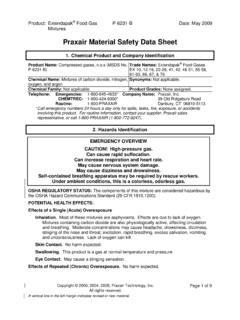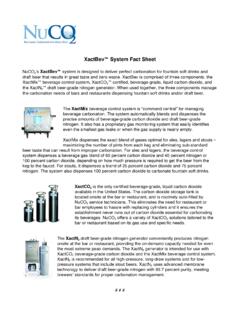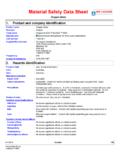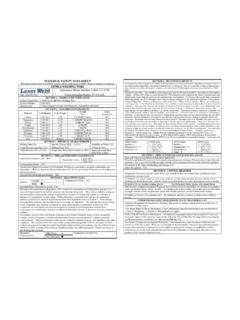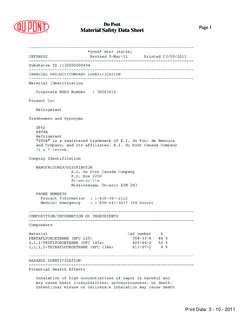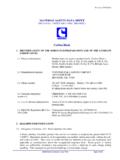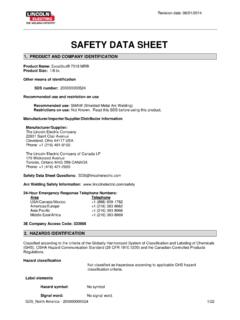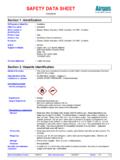Transcription of Praxair Material Safety Data Sheet - NuCO2: …
1 Product: Carbon Dioxide, Refrigerated Liquid P-4573-D Date: December 2009. Praxair Material Safety data Sheet 1. Chemical Product and Company Identification Product Name: Carbon dioxide, refrigerated liquid Trade Names: Liquiflow Liquid Carbon (MSDS No. P-4573-D) Dioxide, Medipure Liquid Carbon Dioxide Chemical Name: Carbon dioxide Synonyms: Carbon dioxide (cryogenic liquid), LCO2, liquefied CO2. Chemical Family: Acid anhydride Product Grades: Industrial, USP. Telephone: Emergencies: 1-800-645-4633* Company Name: Praxair , Inc. CHEMTREC: 1-800-424-9300* 39 Old Ridgebury Road Routine: 1-800- Praxair Danbury, CT 06810-5113. * Call emergency numbers 24 hours a day only for spills, leaks, fire, exposure, or accidents involving this product. For routine information, contact your supplier, Praxair sales representative, or call 1-800- Praxair (1-800-772-9247). 2. Hazards Identification EMERGENCY OVERVIEW. WARNING! Cold liquid and gas under pressure. Can cause rapid suffocation.
2 Can increase respiration and heart rate. May cause nervous system damage. May cause frostbite. May cause dizziness and drowsiness. Self-contained breathing apparatus and protective clothing may be required by rescue workers. This product is a colorless, odorless liquid that transforms to white crystalline particles when discharged from its container. The gas is slightly acidic and may be felt to have a slight, pungent odor and biting taste. OSHA REGULATORY STATUS: This Material is considered hazardous by the OSHA Hazard Communications Standard (29 CFR ). POTENTIAL HEALTH EFFECTS: Effects of a Single (Acute) Overexposure Inhalation. Carbon dioxide gas is an asphyxiant with effects due to lack of oxygen. It is also physiologically active, affecting circulation and breathing. Moderate concentrations may cause headache, drowsiness, dizziness, stinging of the nose and throat, excitation, rapid breathing and heart rate, excess salivation, vomiting, and unconsciousness.
3 Lack of oxygen can kill. Skin Contact. No harm expected from vapor. Prolonged contact with carbon dioxide crystals (snow) could cause frostbite. Cold gas, or liquid or solid carbon dioxide may cause severe frostbite. Copyright 1997, 1999, 2004, 2006, 2009, Praxair Technology, Inc. Page 1 of 10. All rights reserved. A vertical line in the left margin indicates revised or new Material . Product: Carbon Dioxide, Refrigerated Liquid P-4573-D Date: December 2009. Swallowing. An unlikely route of exposure. This product is a gas at normal temperature and pressure. But severe frostbite of the lips and mouth may result from contact with the liquid or solid. Eye Contact. No harm expected from vapor. Cold gas, or liquid or solid carbon dioxide may cause severe frostbite. Effects of Repeated (Chronic) Overexposure. No harm expected to healthy individuals. Where competent medical authority deems that such illness would be aggravated by exposure to carbon dioxide, persons in ill health should be restricted from working with or handling this product.
4 Other Effects of Overexposure. Damage to retinal or ganglion cells and central nervous system may occur. Medical Conditions Aggravated by Overexposure. The toxicology and the physical and chemical properties of carbon dioxide suggest that overexposure is unlikely to aggravate existing medical conditions. CARCINOGENICITY: Carbon dioxide is not listed by NTP, OSHA, or IARC. POTENTIAL ENVIRONMENTAL EFFECTS: None known. For further information, see section 12, Ecological Information. 3. Composition/Information on Ingredients See section 16 for important information about mixtures. COMPONENT CAS NUMBER CONCENTRATION. Carbon dioxide 124-38-9 >99%*. *The symbol > means greater than.. 4. First Aid Measures INHALATION: Immediately remove to fresh air. If not breathing, give artificial respiration. If breathing is difficult, qualified personnel may give oxygen. Call a physician. SKIN CONTACT: For exposure to cold liquid, vapor, or solid, immediately warm frostbite area with warm water not to exceed 105 F (41 C).
5 In case of massive exposure, remove contaminated clothing while showering with warm water. Call a physician. SWALLOWING: An unlikely route of exposure. This product is a gas at normal temperature and pressure. EYE CONTACT: For exposure to cold liquid, vapor, or solid, immediately flush eyes thoroughly with warm water for at least 15 minutes. Hold the eyelids open and away from the eyeballs to ensure that all surfaces are flushed thoroughly. See a physician, preferably an ophthalmologist, immediately. NOTES TO PHYSICIAN: There is no specific antidote. Treatment of overexposure should be directed at the control of symptoms and the clinical condition of the patient. Page 2 of 10. Product: Carbon Dioxide, Refrigerated Liquid P-4573-D Date: December 2009. 5. Fire Fighting Measures FLAMMABLE PROPERTIES: Carbon dioxide cannot catch fire. SUITABLE EXTINGUISHING MEDIA: Nonflammable use media appropriate for surrounding fire. PRODUCTS OF COMBUSTION: Not applicable. PROTECTION OF FIREFIGHTERS: WARNING!
6 Cold liquid and gas under pressure. Evacuate all personnel from danger area. Immediately spray containers with water from maximum distance until cool, taking care not to direct spray onto vents on top of container. Do not discharge sprays into liquid carbon dioxide, which will freeze water rapidly. When containers have cooled, move them away from fire area if without risk. Self-contained breathing apparatus and protective clothing may be required by rescue workers. On-site fire brigades must comply with OSHA 29 CFR Specific Physical and Chemical Hazards. Heat of fire can build pressure in cylinder and cause it to rupture. No part of container should be subjected to a temperature higher than 125 F (52 C). Liquid carbon dioxide containers are equipped with pressure relief devices. Protective Equipment and Precautions for Firefighters. Firefighters should wear appropriate gear for surrounding fire. 6. Accidental Release Measures STEPS TO BE TAKEN IF Material IS RELEASED OR SPILLED: WARNING!
7 Cold liquid and gas under pressure. Personal Precautions. Carbon dioxide is an asphyxiant. Lack of oxygen can kill. Evacuate all personnel from danger area. Use self-contained breathing apparatus and protective clothing where needed. Liquid carbon dioxide will not spill. Flakes of solid carbon dioxide will form at pressures below 67 psig ( kPa) and fall as snow. Shut off leak if you can do so without risk. Ventilate area or move container to a well-ventilated area. Test for sufficient oxygen, especially in confined spaces, before allowing reentry. Environmental Precautions. Prevent waste from contaminating the surrounding environment. Keep personnel away. Discard any product, residue, disposable container, or liner in an environmentally acceptable manner, in full compliance with federal, state, and local regulations. If necessary, call your local supplier for assistance. 7. Handling and Storage PRECAUTIONS TO BE TAKEN IN HANDLING: Never allow any unprotected part of your body to touch uninsulated pipes or vessels containing refrigerated liquids.
8 Flesh will stick to the extremely cold metal and tears when you try to pull free. Use a suitable hand truck to move containers. Containers must be handled and stored in an upright position. Do not drop or tip containers, or roll them on their sides. If valve is hard to open, discontinue use and contact your supplier. For other precautions in using carbon dioxide, see section 16. PRECAUTIONS TO BE TAKEN IN STORAGE: Gas can cause rapid suffocation due to oxygen deficiency. Store and use with adequate ventilation. Do not store in a confined space. Carbon dioxide is heavier than air. It tends to accumulate near the floor of an enclosed space, displacing air and pushing it upward. This creates an oxygen-deficient atmosphere near the Page 3 of 10. Product: Carbon Dioxide, Refrigerated Liquid P-4573-D Date: December 2009. floor. Ventilate space before entry. Verify sufficient oxygen concentration. Close container valve after each use; keep closed even when empty. Storage areas should be clean and dry, free of oils and dust.
9 These collect on condensing coils and impair their efficiency. Temperatures should not exceed 125 F ( C). Cryogenic containers are equipped with a pressure relief device and a pressure-controlling valve. Under normal conditions, these containers periodically vent product to control internal pressure. Use adequate pressure relief devices in systems and piping to prevent pressure buildup; entrapped liquid can generate extremely high pressures. RECOMMENDED PUBLICATIONS: For further information on storage, handling, and use, see Praxair publications P-14-153, Guidelines for Handling Gas Cylinders and Containers; P-15- 073, Safety Precautions for Carbon Dioxide; and P-3499, Safety Precautions and Emergency Response Planning. Obtain from your local supplier. 8. Exposure Controls/Personal Protection See section 16 for important information on by-products generated during use in welding and cutting. COMPONENT OSHA PEL ACGIH TLV-TWA (2009). Carbon dioxide 5,000 ppm 5,000 ppm; 30,000 ppm, 15 min STEL.
10 TLV-TWAs should be used as a guide in the control of health hazards and not as fine lines between safe and dangerous concentrations. IDLH = 40,000 ppm ENGINEERING CONTROLS: Local Exhaust. Use a local exhaust system, if necessary, to keep the concentration of carbon dioxide below all applicable exposure limits in the worker's breathing zone. Mechanical (General). Under certain conditions, general exhaust ventilation may be acceptable to keep carbon dioxide below the exposure limit. Special. None Other. None PERSONAL PROTECTIVE EQUIPMENT: Skin Protection. Wear insulated neoprene gloves and metatarsal shoes for cylinder handling. Protective clothing where needed. Cuffless trousers should be worn outside shoes. Select in accordance with OSHA 29 CFR and When using carbon dioxide or carbon dioxide mixtures in welding and cutting, see Praxair MSDS P-4574, gaseous carbon dioxide, for requirements. Regardless of protective equipment, never touch live electrical parts. Eye/Face Protection.
